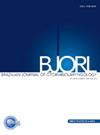Genetic and audiological determinants of hearing loss in high-risk neonates
IF 1.8
4区 医学
Q2 OTORHINOLARYNGOLOGY
引用次数: 0
Abstract
Objective
We aimed to investigate the correlation between prevalent risk factors for high-risk neonates in neonatal intensive care unit and their hearing loss, and to examine the audiological features and genetic profiles associated with different deafness mutations in our tertiary referral center. This research seeks to deepen our understanding of the etiology behind congenital hearing loss.
Methods
We conducted initial hearing screenings, including automated auditory brainstem response, distortion product otoacoustic emission, and acoustic immittance on 443 high-risk neonates within 7 days after birth and 42 days (if necessary) after birth. Neonates who failed initial screenings underwent further diagnostic tests at 3 months. The risk factors were analyzed retrospectively by Chi-Square test and stepwise logistic regression. Genetic analysis involved a deafness sequencing panel targeting 19 pathogenic variants across four genes (GJB2, GJB3, SLC26A4, and MT-RNR), applied to both the study cohort and a larger hearing screening cohort of 14863 neonates from our center and different medical centers in the same region.
Results
Out of the 443 high-risk neonates, 222 failed their diagnostic hearing tests. Logistic regression identified preterm birth, neonatal hyperbilirubinemia and advanced maternal age (≧35 yr) as significant risk factors for hearing loss. Genetic screening of 33 neonates who failed the diagnostic tests revealed that 7 (21.21%) carried at least one pathogenic variant, with identified 1 homozygotes and 3 heterozygotes in the GJB2, 1 homozygotes and 1 heterozygotes in the SLC26A4 gene, and 1 homoplasmic variant in the MT-RNR (12SrRNA). In the larger hearing screening cohort, 497 (3.34%) were genetically positive for deafness mutations, among whom 29 had the diagnostic hearing tests and 7 eventually diagnosed with hearing loss. Of the rest 468 neonates who didn’t have the diagnostic tests, 445 (95.09%) passed the hearing screening tests.
Conclusion
Preterm birth, neonatal hyperbilirubinemia and advanced maternal age are critical risk factors for hearing impairment in high-risk neonates. Mutations such as c.235delC in GJB2 and c.919-2A>G in SLC26A4 are the most common. Long-term follow-up of neonates carrying heterozygous variants, particularly in genes like GJB3, is necessary to understand their progression and hearing outcomes. This study highlights the importance of deafness gene screening in neonates to ensure accurate diagnosis and effective intervention.
Level of evidence
Level 3.
高危新生儿听力损失的遗传和听力学决定因素。
目的:探讨新生儿重症监护室高危新生儿常见危险因素与听力损失的相关性,并研究三级转诊中心不同耳聋突变相关的听力学特征和遗传谱。本研究旨在加深我们对先天性听力损失病因学的理解。方法:对443例高危新生儿在出生后7天和42天(如有必要)内进行初步听力筛查,包括自动听觉脑干反应、畸变产物耳声发射和声阻抗。未通过初步筛查的新生儿在3个月时接受进一步的诊断测试。采用卡方检验和逐步logistic回归对危险因素进行回顾性分析。遗传分析涉及针对四个基因(GJB2、GJB3、SLC26A4和MT-RNR)的19个致病变异的耳聋测序小组,应用于研究队列和来自本中心和同一地区不同医疗中心的14863名新生儿的更大听力筛查队列。结果:443例高危新生儿中,222例未通过听力诊断测试。Logistic回归分析发现,早产、新生儿高胆红素血症和高龄产妇(≧35岁)是听力损失的重要危险因素。对33例未通过诊断试验的新生儿进行遗传筛查,发现7例(21.21%)携带至少一种致病变异,其中GJB2基因1个纯合子和3个杂合子,SLC26A4基因1个纯合子和1个杂合子,MT-RNR (12SrRNA)基因1个同质变异。在较大的听力筛查队列中,497例(3.34%)耳聋突变基因阳性,其中29例进行了诊断性听力测试,7例最终被诊断为听力损失。其余468名未进行诊断测试的新生儿中,有445名(95.09%)通过了听力筛查测试。结论:早产、新生儿高胆红素血症和高龄产妇是高危新生儿听力障碍的重要危险因素。GJB2中的c.235delC和SLC26A4中的c.919-2A>G等突变是最常见的。对携带杂合变异体的新生儿,特别是GJB3等基因的新生儿进行长期随访,对于了解其进展和听力结果是必要的。本研究强调了新生儿耳聋基因筛查对于确保准确诊断和有效干预的重要性。证据等级:三级。
本文章由计算机程序翻译,如有差异,请以英文原文为准。
求助全文
约1分钟内获得全文
求助全文
来源期刊

Brazilian Journal of Otorhinolaryngology
OTORHINOLARYNGOLOGY-
CiteScore
3.00
自引率
0.00%
发文量
205
审稿时长
4-8 weeks
期刊介绍:
Brazilian Journal of Otorhinolaryngology publishes original contributions in otolaryngology and the associated areas (cranio-maxillo-facial surgery and phoniatrics). The aim of this journal is the national and international divulgation of the scientific production interesting to the otolaryngology, as well as the discussion, in editorials, of subjects of scientific, academic and professional relevance.
The Brazilian Journal of Otorhinolaryngology is born from the Revista Brasileira de Otorrinolaringologia, of which it is the English version, created and indexed by MEDLINE in 2005. It is the official scientific publication of the Brazilian Association of Otolaryngology and Cervicofacial Surgery. Its abbreviated title is Braz J Otorhinolaryngol., which should be used in bibliographies, footnotes and bibliographical references and strips.
 求助内容:
求助内容: 应助结果提醒方式:
应助结果提醒方式:


